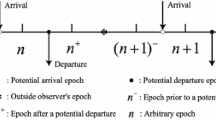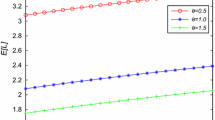Abstract
This paper considers the departure process and the optimal control strategy for a discretetime Geo/G/1 queueing model in which the system operates under the control of multiple server vacations and Min(N, V)-policy. Using the law of total probability decomposition, the renewal theory and the probability generating function technique, the transient and the steady-state probabilities that the server is busy at any epoch n+ are derived. The authors also obtain the explicit expression of the probability generating function for the expected number of departures occurring in the time interval (0+, n+] from any initial state. Meanwhile, the relationship among departure process, server’s state process and service renewal process in server busy period is found, which shows the special structure of departure process. Especially, some corresponding results of departure process for special discrete-time queues are directly gained by our results. Furthermore, the approximate expansion for calculating the expected number of departures is presented. In addition, some other important performance measures, including the expected length of server busy period, server’s actual vacation period and busy cycle period etc., are analyzed. Finally, some numerical results are provided to determine the optimum value N* for minimizing the system cost under a given cost structure.
Similar content being viewed by others
References
Ferng H W and Chang J F, Connection-wise end-to-end performance analysis of queueing networks with MMPP inputs, Performance Evaluation, 2001, 43(1): 39–62.
Ferng H W and Chang J F, Connection-wise end-to-end delay analysis in ATM networks, IEICE Transactions on Communications, 2000, 83(3): 659–671.
Giambene G, Queuing Theory and Telecommunications: Networks and Applications, Springer, New York, 2005.
Burke P J, The output of a queueing system, Operations Research, 1956, 4(6): 699–704.
Finch P D, The output process of the queueing system M/G/1, Journal of the Royal Statistical Society (Series B), 1959, 21(2): 375–380.
Daley D J, The correlation structure of the output process for some single server queueing systems, Annals of Mathematical Statistics, 1968, 39(3): 1007–1019.
Kempa W M, Analysis of departure process in batch arrival queue with multiple vacations and exhaustive service, Communications in Statistics — Theory and Methods, 2011, 40(16): 2856–2865.
Lim S Y, Hur S, and Noh S J, Departure process of a single server queueing system with Markov renewal input and general service time distribution, Computers and Industrial Engineering, 2006, 51(3): 519–525.
Ferng H W and Chang J F, Departure process of BMAP/G/1 queues, Queueing Systems, 2001, 39: 109–135.
Choi Y and Momčilović P, On the departure process of the linear loss network, Queueing Systems, 2014, 78(2): 155–187.
Tang Y H, The departure process of the M/G/1 queueing model with server vacation and exhaustive service discipline, Journal of Applied Probability, 1994, 31(4): 1070–1082.
Tang Y H, A new and direct method of analysis the departure processes of single server queueing systems, Acta Mathematica Scientia, 1996, 16B(Supp.): 131–138.
Tang Y H, On the transient departure process of MX/G/1 queueing system with single server vacation, Journal of Systems Science and Complexity, 2007, 20(4): 562–571.
Tang Y H, The departure process for the MX/G/1 queueing system with server vacations, Mathematica Applicata, 2007, 20(3): 478–484.
Kempa WM and Kurzyk D, Transient departure process in M/G/1/K-type queue with threshold server’s waking up, 23rd International Conference on Software, Telecommunications and Computer Networks (SoftCOM), Split, Croatia, 2015, 32–36.
Kempa W M, Study on time-dependent departure process in a finite-buffer queueing model with BMAP-type input stream, IEEE 2nd International Conference on Cybernetics (CYBCONF), Gdynia, Poland, 2015, 245–250.
Whitt W, A Poisson limit for the departure process from a queue with many busy servers, Operations Research Letters, 2016, 44(5): 602–606.
Wei Y Y, Tang Y H, Gu J X, et al., Departure process of M/G/1 queueing system under Min(N,D)-policy, Chinese Journal of Engineering Mathematics, 2016, 33(4): 369–381 (in Chinese).
Ferng H W and Chang J F, The departure process of discrete-time queueing systems with Markovian type inputs, Queueing Systems, 2000, 36: 201–220.
Luo C Y, Tang Y H, Cao B S, et al., Decomposition of the departure process for a discrete-time Geo(λ1,λ2)/G/1(ES,MV ) queue, Acta Mathematica Sinica, 2013, 56(5): 185–194 (in Chinese).
Tian N S, Xu X L, and Ma Z Y, Dicrete-Time Queueing Theory, Science Press, Beijing, 2008 (in Chinese).
Jury E I, Theory and Application of the Z-Transform Method, John Wiley and Sons, Inc., New York, 1964.
Ross S M, Stochastic Processes, Academic Press, New York, 1983.
Takagi H, Queueing Analysis: A Foundation of Performance Evaluation, Vol. 3: Discrete-Time Systems, North-Holland, Amsterdam, 1993.
Lan S J and Tang Y H, Geo/G/1 discrete-time queue with multiple server vacations and Min(N, V)-policy, Systems Engineering — Theory & Practice, 2015, 35(3): 799–810 (in Chinese).
Author information
Authors and Affiliations
Corresponding author
Additional information
This research was supported by the National Natural Science Foundation of China under Grant Nos. 71571127 and 71171138.
This paper was recommended for publication by Editor WANG Shouyang.
Rights and permissions
About this article
Cite this article
Lan, S., Tang, Y. The structure of departure process and optimal control strategy N* for Geo/G/1 discrete-time queue with multiple server vacations and Min(N, V)-Policy. J Syst Sci Complex 30, 1382–1402 (2017). https://doi.org/10.1007/s11424-017-5279-5
Received:
Revised:
Published:
Issue Date:
DOI: https://doi.org/10.1007/s11424-017-5279-5




